by Winding Pathways | Nov 30, 2017 | Nature, Reflections/Profiles, Wonderment
Carole Teator: Thank you for inviting my story. And thank you for the column on the catalpa tree. I do enjoy them, particularly when they are in bloom.
This is a story of losing a tree. Carole shares that it “… helped me realize how deeply one can mourn the loss of a non-sentient being.”
Cottonwood
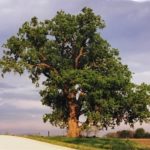 “I recently came across the attached photo of a cottonwood tree that I once knew and this old friend has been on my mind since. It grew along Austin Road, north of Marion, and I came to know it when visiting friends who live nearby. When I could, I would walk to visit the tree and eventually photographed it in every season. It was huge—perhaps 20 feet in circumference?—and it stood alone, between a field and the road. Nearby is a small woodland, the proximity of which may have made the cottonwood seem even more solitary at the side of the road.
“I recently came across the attached photo of a cottonwood tree that I once knew and this old friend has been on my mind since. It grew along Austin Road, north of Marion, and I came to know it when visiting friends who live nearby. When I could, I would walk to visit the tree and eventually photographed it in every season. It was huge—perhaps 20 feet in circumference?—and it stood alone, between a field and the road. Nearby is a small woodland, the proximity of which may have made the cottonwood seem even more solitary at the side of the road.
“One day, one of my friends who lived near the tree dropped me off at the Cedar Rapids Airport. A terrible storm blew in, delaying my flight and making me very concerned about my friend and her young son, who I knew would be driving on Highway 13 at the height of the storm. When I was able, I called to check on them. She said they were fine, but that the old cottonwood had blown over in the storm. Shock and sadness washed over me, and I was as surprised by this visceral reaction as much as I was by the news. I mean, it was a tree I only saw every few weeks and I only had known it a few years of its life. But it seemed a connection to the past and a sentinel of beauty and solitude that was now gone. I had connected to this tree more than I had understood, or even understand now. I continue to mourn its passing, but I am so grateful for the photos I took of it that remind me of its beauty and grace.”
Catalpa
Bev Hannon: “Your Sunday article on catalpa trees brought back lots of memories. We had two trees between the sidewalk and street at the house I grew up in, in Manchester, IA. I loved those trees and founds all kinds of way to use the blossoms and beans as a child. I think I even used to climb the trees, ‘though not successfully. I held “tea parties” in the shade under them, serving the early beans in my little tea dishes and of course, decorating my table with the blossoms.
“Unfortunately, the trees are long gone, as well as the house I grew up in. It burned down, and someone set up a double wide trailer facing the other street (corner lot), not West Marion St., so even my old address is gone. 🙁 But the memories live on.
“Thanks for your good words for Catalpas.”
The Ramsey Table
Marion Patterson: While clearing out the attic, recently, I came across “The Ramsey Table”. This was a roughly fashioned coffee-type table my folks made shortly after we were married and brought to us in Iowa. Dad had found an 18″ wide plank from the home we lived in Goffstown, NH. Purportedly, (one of) the oldest in town. The home did pre-date the Revolution and was for sure haunted! One family that lived there was “The Ramseys.” Much to my folks’ bemusement, a friend and I concocted all sorts of adventures surrounding this unknown family. Thus the name of the table.
Mom placed a variety of sentimental objects in the little shadow box cubbies that Dad had made. Many of these I later replaced as their meaning dissolved. Glued-down pennies of significant dates like when we were born, graduated high school and college, got married remained. And, a little memento of “Baby Magaret” a long-lost relative from 1878 Chambersburg, PA, who died in infancy.
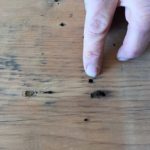
Square Nail Holes
It was time to dismantle The Ramsey Table as we have never had a good place to display and use it. I did so reflectively. A further look at the plank revealed some interesting features. It was a decades-old pine tree with three knots across the middle. As a young tree, it grew fairly fast in New England soil in years when sufficient moisture helped it along. Later the rings grew closer together until they were indistinguishable. Revealing less moisture and more competition perhaps as it grew.
Most interesting to us were the widely spaced square nail holes! Their presence and configuration confirmed that this was an old piece of lumber. So, we have kept the plank and are thinking about the best way to honor it and Mom and Dad’s gift of The Ramsey Table.
The Treehouse
Rich Patterson
When I was eight or ten years old Dad helped a friend and me construct a treehouse in a multibranched gray birch tree that grew behind our house in New Jersey. It was mostly platform four or five feet above the ground.
Growing nearby was a tall maple on high ground overlooking Cedar Lake. It was easy to climb trees with horizontal branches perfectly spaced apart. My friend and I carried boards way up in the tree, perhaps 40 feet above the ground, and we made a platform there. We even made a flagpole and hoisted it above the tree’s top.
Grandma Zieger lived close by and saw us high in the tree and alerted Mom and Dad, as a fall from that height would be serious. They were unworried, as they thought we were in the low tree. Only later did they discover the lofty perch and discouraged its use.
Pacific Madrone
Rich Patterson
In the late 1960s, I found myself in the army as a neophyte infantryman. For a while, I was stationed at Fort Lewis, Washington on the south end of Puget Sound in the rainforest, a land of giant trees.
One evening my company was told to gear up and, squad by squad, we climbed aboard helicopters. Soon we took off in the darkness and not long later landed. A lieutenant told us to jump out and make a defensive perimeter. We could expect an attack at dawn. It was a big war game, the blue army vs. the green one.
So, we formed sort of a circle as best we could in the darkness and took turns on guard duty all night. Two of us would be awake for an hour while the rest slept. At the end of an hour, the guard duty guys would wake up the next shift, and so on.
I ended up with the dawn shift and got poked awake around 4:30 in the morning. With a partner, we peer outward searching for danger, but we could see nothing. It’s true that the darkest hour is just before dawn, but as the earth turned toward the sun the land lightened and gradually I could make out the trunks of huge Douglas fir and cedars. Beneath them was a tree so unusual it riveted my eyes. Small and twisted, it had large deciduous type leaves and looked like it belonged in the tropics. I’d never been in the rainforest before and was so fascinated I stood up to get a better look.
Instantly an M-16 spit out a clip’s worth of blanks. In those days blanks had bullets made of compressed paper. Several splattered on my chest and hurt but did no damage. Within seconds and army “referee” approached, put a colorful tag on me and pronounced me dead. I was told to walk back to the LZ (helicopter landing zone).
It was the Pacific Madrone that helped me realize that curiosity about nature can be dangerous.
Old Henry
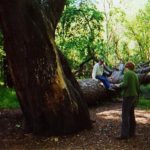
Old Henry
R and M Patterson: Folks who have visited Indian Creek Nature Center over the decades remember fondly “Old Henry”.
This large silver Maple along Indian Creek just off the Sac and Fox Trail, grew up when the Center was a farm, was flooded regularly, thrived in the dense moist soil and was home to many animals. Its girth beckoned visitors to wrap multiple arms around its massive trunks and cool off in its shade. Kids and adults alike loved Old Henry. Cedar Rapidians returning for the Holidays often made pilgrimages to see Old Henry and reminisce about their adventures there.
So, many mourned when its branches started to fall off, when winds toppled large sections of its trunk and when it finally, keeled over from age. Its limbs lay scattered about and kids still climbed all over them until these rotted away. But, Old Henry’s passing opened up space for new Henrys to grow. Some are good sized. Birds and mammals have returned to nest and rest. Insects and worms still ply the soils.
Perhaps one of the most touching tributes over the years was that each late fall, some kindly soul would leave a garland around Old Henry with a few tidbits for the animals. Even as Old Henry became littler and littler, this anonymous person would trek out to Old Henry and leave love offerings. So, Rich was moved when this week he walked past Old Henry, now a tiny stump, and saw a garland wrapped around the remains and a few tidbits for the animals. A fitting tribute to an old friend. Thank you.
by Winding Pathways | Nov 23, 2017 | Wonderment
This past year I have again kept a Gratitude Jar and almost daily write on a 2″x2″ sticky note the date and a Gratitude. Periodically, I pour out the notes and look at them. Since this is the time many in America are expressing on social media their gratitudes, I thought I’d share some randomly from my Gratitude Jar.
11-18 After a dusty fall of kitchen renovations: Cleaned the kitchen! (Then on to the rest of the house!)
8-31 Head Ache medicine.
9-18 Wine with Rich.
9-20 Everything organized for the trip East.
5-3 Teaching with Terri Off.
9-9 Hike with Norlanders. (At Beaver Creek Valley St. Pk. MN. A Lovely retreat!
7-20 Talk with other students in the Habits of the Mind class.
1-24 Chat with Margee after class.
2-13 Good report from Doctor.
5-10 Cafe McGregor.
11-5 Made Pumpkin Pie!
11-1 Found tiny screw to glasses.
5-22 Helped a congregant in need.
2-19 Call from Nancy.
6-30 Movie “Following Roots.”
5-18 Pizza for Cyd’s B-day.
4-6 Conversation with a HyVee worker who has color deficiency.
10-31 End of an amazing trip around Washington State.
12-16 Note from Bonnie in Washington State. She was a good friend to Mom and we’ve stayed in touch since she died.
3-2 Shelly got the missing files back!
Practicing an “Attitude of Gratitude” changes the karma and increases our positive energy. This has been fun and rewarding to do. At the end of the year, I will look at them all and ceremonially burn them. Then, start again!

Wise words
May your days be blessed with Gratitude and may you share with others.
by Winding Pathways | Nov 16, 2017 | Travel/Columns
TRAVELING WITH BINOCULARS
Disclosure: Years ago we were asked to serve on the Alpen Optics Birding Pro-Staff and periodically we receive optics to test. Following is a report on using mini-binoculars while traveling.
In October we enjoyed a 1600-mile, 12-day clockwise loop around Washington State. After picking up our rental car at the Spokane airport our journey took us through deserts, mountain passes, the Olympic rainforest, and even across Puget Sound on a ferry.
We enjoyed spotting new bird species, sea lions, jellyfish, Roosevelt elk, and a host of other wildlife. Good thing we brought along binoculars! We wouldn’t dream of traveling without binoculars and use them constantly. Even when we trek to New York City we tote along a pair. But, for this trip, they presented a dilemma.
We wanted to avoid checking baggage on the plane to save cost and the possibility of a lost suitcase.

Rich with compact binoculars.
Delta Airlines limited us to a small suitcase that we could carry on the plane. Squeezing nearly two weeks’ worth of clothes and supplies into these packs was a challenge. It became obvious that we couldn’t fit in our full-size binocs. Mini Binoculars to the rescue! Our Alpen Wings ED compact binoculars easily nested into a hiking boot that we tucked in the pack.
For all around general binocular use, and when we’re traveling by car, we always use full-size binoculars. They fit our hands well, provide a bright image, even at dawn and dusk, and their field of view is wide. Their downside is bulkiness.
Many optical companies sell high-quality compact binoculars. Go for quality. Inexpensive models are nearly useless. Here are the pros and cons of mini binoculars:
PRO
Compact binoculars are handy because they are small. They easily fit in a glove compartment, purse, or jacket pocket and take little space in a suitcase. Mini’s are ideal for travel. Quality ones have clear optics.
Having a pair of mini binoculars handy is always better than not having binoculars.
CON
Mini binoculars have a limited field of view and are rarely as good in low light situations as their full-size cousins. We find them a little harder to use and hold than full-size models and would never choose to use minis for long viewing sessions or if we went on specific birding excursions. But they are invaluable when size and weight are limited.
The best solution is to have two pairs of binoculars. One full sized model for general use and minis for travel and convenience.
by Winding Pathways | Nov 9, 2017 | Nature, Trees/Shrubs
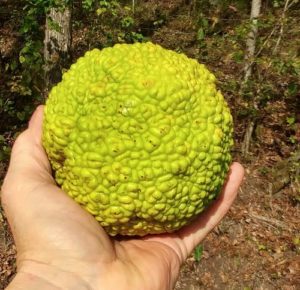 This fall we’ve noticed Osage Orange fruits for sale in grocery stores and roadside stands. They are fascinating and have a delightful fresh citrus scent.
This fall we’ve noticed Osage Orange fruits for sale in grocery stores and roadside stands. They are fascinating and have a delightful fresh citrus scent.
These are often called Hedge Apples, and many people call the tree they grow on Hedge. More properly the tree is called an Osage Orange and the fruits are Osage Oranges. To add confusion some people, call the tree Bodark because its springy tough wood was once used to make bows.
The Osage Orange once lived in a relatively small area of Texas and Oklahoma but because it is tough, drought resistant, and thorny it was commonly planted in places outside its native range. The tree’s branches twist in many directions with thorn-studded twigs. When planted in a row, the trees created a living fence that cattle wouldn’t cross. In the days before barbed wire was invented millions of Osage Oranges were planted for fences.
The wood is hard and heavy and is outstanding for firewood, but cutting it is challenging because of all the thorns.
Does a Hedge Apple in the basement keep insects away? Many people think so and annually buy or collect a few. We think it’s an ineffective way to keep out insects and find caulking entry points better for excluding bugs from our home.
In recent years an oil extracted from hedge apples has been used in shampoo and hair conditioners, and many people love the product. It is marketed as POMIFERA in honor of the tree’s Latin name Maclura pomifera. Todd Johnson, a native Bloomfield, Iowan, has cashed in on the Hedge Apple industry.
Hungry squirrels sometimes eat the seeds hidden inside hedge apples and livestock sometimes dine on them but they are inedible to humans.
There’s no harm in putting a few hedge apples in the basement but don’t count on them to keep away bugs.
by Winding Pathways | Nov 2, 2017 | Chickens, Mammals, Nature
Below is a guest blog by Arianne Waseen about a visit by an opossum. Thanks, Arianne!
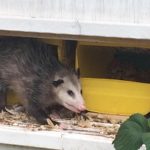
“Possum come aknockin’ at the door.”
“I went out in the afternoon a few weeks ago to look for eggs. I opened up the large door on the front of our coop, and in the nest box was something grey and furry and curled up in a little ball. My first thought was that it was a cat, but looking more closely it was definitely possum fur. I yelled and jumped a bit, and ran in to tell my husband and mother-in-law to come take a look. By the time we got back the possum had woken up. We opened up a little door we have at the back of the nest box and my mother in law encouraged the possum to jump down by prodding it with a broom from the front of the nest box. It jumped down and ran off. The opossum has come back a few times, and while it has not harmed our chickens, we are getting fewer eggs than we should be, and the possum has suspiciously glossy fur.”
 “I recently came across the attached photo of a cottonwood tree that I once knew and this old friend has been on my mind since. It grew along Austin Road, north of Marion, and I came to know it when visiting friends who live nearby. When I could, I would walk to visit the tree and eventually photographed it in every season. It was huge—perhaps 20 feet in circumference?—and it stood alone, between a field and the road. Nearby is a small woodland, the proximity of which may have made the cottonwood seem even more solitary at the side of the road.
“I recently came across the attached photo of a cottonwood tree that I once knew and this old friend has been on my mind since. It grew along Austin Road, north of Marion, and I came to know it when visiting friends who live nearby. When I could, I would walk to visit the tree and eventually photographed it in every season. It was huge—perhaps 20 feet in circumference?—and it stood alone, between a field and the road. Nearby is a small woodland, the proximity of which may have made the cottonwood seem even more solitary at the side of the road.




 This fall we’ve noticed Osage Orange fruits for sale in grocery stores and roadside stands. They are fascinating and have a delightful fresh citrus scent.
This fall we’ve noticed Osage Orange fruits for sale in grocery stores and roadside stands. They are fascinating and have a delightful fresh citrus scent.